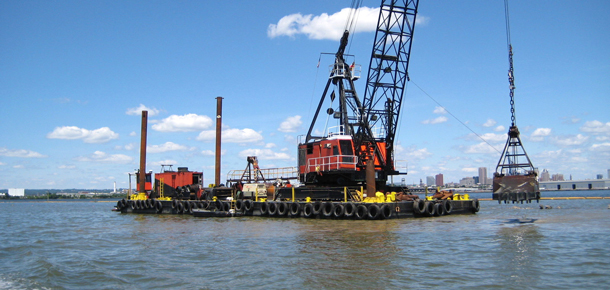Knauss legislative fellowships in Congress help build careers — and they're fun and educational. See our video and fact sheet for details.
Dredging

Since colonial times, shipping has been an economic powerhouse in Maryland. The Port of Baltimore, one of the busiest on the mid-Atlantic, moves tens of millions of tons of freight cargo every year, bringing in goods from all over the world. In the process, the port generates billions of dollars in business and tax revenues each year.
But shipping in Maryland also comes with trade-offs. In order to safely navigate, today’s large cargo vessels need water that’s at least 50 feet deep. And that means that deep channels have to be dug, or dredged, throughout the Chesapeake Bay continually.
Every year, the Maryland Port Administration and the U.S. Army Corps of Engineers dredge roughly 4.5 million cubic yards of sediment from the Bay. Of those, 1.5 million come just from the Patapsco River, which connects the estuary to Baltimore.
Much of that sediment has, over generations, accumulated high levels of pollutants. Those include heavy metals and pesticides that can be harmful to human health. That’s left scientists and state regulators facing a large dilemma: what should Maryland do with the tons upon tons of dredged material from the Patapsco? In the past, authorities have gone to great expense to dump dredge materials into containment areas, creating new islands in the Bay. Instead, maybe there is a way to make money from selling these dredge materials or “dredge spoils.”
Innovative Reuse of Baltimore Harbor Sediments
To help the port administration answer this question, Maryland Sea Grant convened an independent scientific review of sediments around Baltimore Harbor. The goal was to inform new, and sustainable, uses for this dredged material.
Among other things, the review team found that:
- All sediments tested had contamination levels that exceeded health standards for agricultural use, meaning dredged materials couldn’t be recycled as farming topsoil.
- But sediments from certain locations did meet health standards for residential use, meaning these sediments could be used as soil in non-agricultural areas.
- Other sediments were cleared for industrial use. These sediments could be used to fill in old mines or gravel pits. More promising, they could also be processed to make lightweight building bricks and other materials.
In all, the team’s results suggest that dredged material from Baltimore Harbor could be used in a range of beneficial uses. By taking advantage of these, Maryland could make channel dredging in the Chesapeake Bay more sustainable.
Read more about this research:
- Sediment in Baltimore Harbor: Summary of an Independent Review -- Four-page summary
- Sediment in Baltimore Harbor: Quality and Suitability for Innovative Reuse -- Full report (173 pages)
The Chesapeake Research Consortium cosponsored this study.





